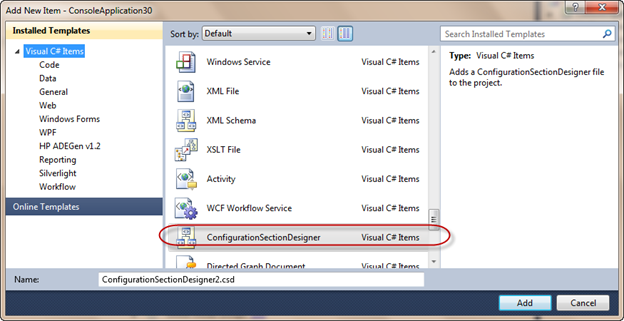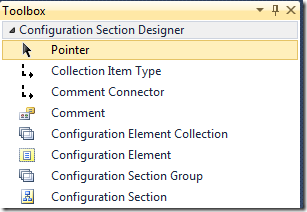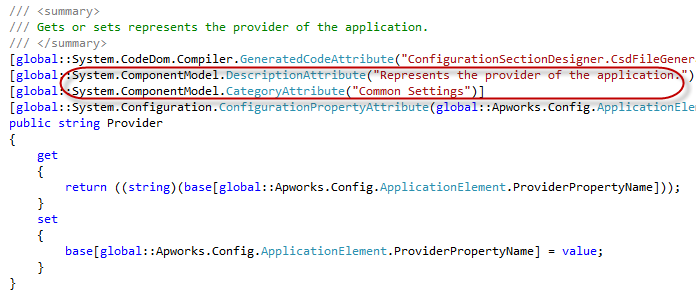在进行框架开发的过程中,我们往往需要对配置文件的结构进行设计,以便产生一套完整的配置方案,供开发人员在使用框架时能对框架进行配置。对于某些大型的框架,其配置节点的结构可能相当复杂,比如某个配置节点(Configuration Element)可以有属性,还可以在其下挂载多个其它的配置节点或者多个配置节点集合(Configuration Element Collection)。如果使用手动编写代码的方式来维护与配置相关的代码,势必会出现大量的重复劳动,比如,需要给每个配置属性添加System.Configuration.ConfigurationPropertyAttribute特性,需要为各个配置节点集合采用相同的代码编写模式(例如重写其中的CreateElement等方法)。这样做不仅耗时而且容易出错。更进一步,Visual Studio支持智能感知技术,如果我们在配置文件编辑器上设置了所要用到的配置信息XSD Schema文件,我们就可以利用智能感知方便快速地编写配置文件。然而,如果我们的配置节点采用手工代码维护,那么在编写完代码之后,还需要另外编写一套XSD Schema文件,以使得开发人员在使用我们的框架时,能够享受到智能感知带来的便捷,这样做不仅工作量大,而且一旦配置信息结构变得复杂,我们就很难确保代码与XSD Schema之间的对应关系。
今天我向大家介绍一款个人觉得比较不错的基于.NET的配置文件设计工具:Configuration Section Designer。它是一款使用Microsoft Visualization & Modeling SDK开发的面向配置文件设计领域的领域特定语言(DSL,有关DSL的知识,我会在后续的博客文章中向大家介绍)。如果你使用的是Visual Studio 2005/2008,你可以去Configuration Section Designer的主页下载安装包。如果你使用的是Visual Studio 2010,那么你还可以使用VS2010的Extension Manager来找到这个设计工具。
下载与安装
可以到Configuration Section Designer的下载页面下载并安装该工具。如果你使用的是Visual Studio 2005/2008,你将得到一个EXE的安装程序;如果你使用的是Visual Studio 2010,你将得到一个VSIX的扩展包。我使用的是Visual Studio 2010,因此接下来都会以Visual Studio 2010进行介绍。
在得到VSIX扩展包后,双击直接打开运行就可以将其安装到Visual Studio 2010的开发环境中。
新建配置文件项目
首先你可以使用Visual Studio 2010随便创建一个项目(比如Class Library或者Console Application都可以),然后在这个项目上单击鼠标右键,选择Add –> New Item菜单,这将打开Add New Item对话框,在Installed Templates –> Visual C# Items节点下,找到ConfigurationSectionDesigner,更改名称后单击Add按钮。
在完成Designer Surface的创建之后,我们可以看到在项目中多了一个.csd的文件,在Toolbox中,也出现了与配置文件设计相关的工具:
看上去是不是有点像ADO.NET Entity Framework的设计器?不错,这就是Microsoft Visualization & Modeling SDK给我们带来的强大功能:它允许开发人员设计自己的领域特定语言(Domain Specific Language, DSL),并以VSIX等扩展包的方式集成到Visual Studio开发环境中。
功能介绍
本文不打算讲解如何使用Configuration Section Designer来设计配置文件,只对其中的一些非常不错的功能进行介绍。
自动化代码与文件的生成
对于一款DSL来说,自动化代码生成不算是什么强大的功能,但是这款工具不仅仅会产生代码,而且还会产生与之相关的XSD Schema以及配置文件样本(Sample Configuration File),能让开发者直观地看到最终效果:
配置文件样本测试
在设计配置文件的过程中,你可以直接双击产生的.csd.config(比如上面的ConfigurationSectionDesigner1.csd.config)文件,然后在里面进行编辑,来测试你的设计是否正确。注意这个编辑过程是自带有智能感知的:
Windows Forms设计器的支持
一个专业的开发框架在向用户提供配置相关的代码以及XSD Schema的同时,还应该为用户提供方便的配置文件编辑器(例如Microsoft Patterns & Practices Enterprise Library通常都会带有面向各种Application Block的配置编辑器)。试想我们将用Windows Forms及其Property Grid控件来设计一款配置文件编辑器,在将配置对象绑定到Property Grid时,Property Grid会通过反射将该对象下所有的属性都显示出来。然而对于配置编辑器而言,我们不仅需要控制配置对象中各个属性的显示方式,而且还需要对这些属性进行一些描述和归类。如果是手工维护框架中的配置代码,这个问题好解决:直接向每个属性手工添加诸如System.ComponentModel.DescriptionAttribute、System.ComponentModel.BrowsableAttribute等特性即可。但如果整个配置代码都是由某工具自动化生成的,那么你就不能直接在生成的代码上就行手工修改,而只能通过System.ComponentModel.DataAnnotations.AssociatedMetadataTypeTypeDescriptionProvider、System.ComponentModel.CustomTypeDescriptor以及System.ComponentModel.PropertyTypeDescriptor类来扩展MetadataType Description,然后使用System.ComponentModel.DataAnnotations.MetadataTypeAttribute特性以在用于描述源类型的元数据类型上进行特性设置。以下是这种实现方式的相关代码:
public class MyAssociatedMetadataTypeTypeDescriptionProvider : AssociatedMetadataTypeTypeDescriptionProvider
{
public MyAssociatedMetadataTypeTypeDescriptionProvider(Type type)
: base(type) { }
public MyAssociatedMetadataTypeTypeDescriptionProvider(Type type, Type associatedMetadataType)
: base(type, associatedMetadataType) { }
private ICustomTypeDescriptor Descriptor { get; set; }
public override ICustomTypeDescriptor GetTypeDescriptor(Type objectType, object instance)
{
if (null == this.Descriptor)
this.Descriptor = new MyCustomTypeDescriptor(base.GetTypeDescriptor(objectType, instance));
return this.Descriptor;
}
}
public class MyCustomTypeDescriptor : CustomTypeDescriptor
{
public MyCustomTypeDescriptor(ICustomTypeDescriptor wrappedTypeDescriptor)
{
this.WrappedTypeDescriptor = wrappedTypeDescriptor;
}
private ICustomTypeDescriptor WrappedTypeDescriptor { get; set; }
public override AttributeCollection GetAttributes()
{
return this.WrappedTypeDescriptor.GetAttributes();
}
public override PropertyDescriptorCollection GetProperties()
{
PropertyDescriptorCollection properties = this.WrappedTypeDescriptor.GetProperties();
List<PropertyDescriptor> list = new List<PropertyDescriptor>();
foreach (PropertyDescriptor descriptor in properties)
list.Add(new MyPropertyDescriptor(descriptor));
return new PropertyDescriptorCollection(list.ToArray(), true);
}
public override PropertyDescriptorCollection GetProperties(Attribute[] attributes)
{
return this.GetProperties();
}
}
public class MyPropertyDescriptor : PropertyDescriptor
{
public MyPropertyDescriptor(PropertyDescriptor wrappedPropertyDescriptor)
: base(wrappedPropertyDescriptor)
{
this.WrappedPropertyDescriptor = wrappedPropertyDescriptor;
}
private PropertyDescriptor WrappedPropertyDescriptor { get; set; }
public override void AddValueChanged(object component, EventHandler handler)
{
this.WrappedPropertyDescriptor.AddValueChanged(component, handler);
}
public override bool CanResetValue(object component)
{
return this.WrappedPropertyDescriptor.CanResetValue(component);
}
public override Type ComponentType
{
get
{
return this.WrappedPropertyDescriptor.ComponentType;
}
}
public override bool IsReadOnly
{
get
{
return this.WrappedPropertyDescriptor.IsReadOnly;
}
}
public override object GetValue(object component)
{
return this.WrappedPropertyDescriptor.GetValue(component);
}
public override Type PropertyType
{
get
{
return this.WrappedPropertyDescriptor.PropertyType;
}
}
public override void RemoveValueChanged(object component, EventHandler handler)
{
this.WrappedPropertyDescriptor.RemoveValueChanged(component, handler);
}
public override void ResetValue(object component)
{
this.WrappedPropertyDescriptor.ResetValue(component);
}
public override void SetValue(object component, object value)
{
List<Attribute> attributes = new List<Attribute>();
this.FillAttributes(attributes);
foreach (Attribute attribute in attributes)
{
ValidationAttribute validationAttribute = attribute as ValidationAttribute;
if (null == validationAttribute)
continue;
if (!validationAttribute.IsValid(value))
throw new ValidationException(validationAttribute.ErrorMessage, validationAttribute, component);
}
this.WrappedPropertyDescriptor.SetValue(component, value);
}
public override bool ShouldSerializeValue(object component)
{
return this.WrappedPropertyDescriptor.ShouldSerializeValue(component);
}
public override bool SupportsChangeEvents
{
get
{
return this.WrappedPropertyDescriptor.SupportsChangeEvents;
}
}
}
// 以下是使用方式:
[MetadataType(typeof(ApplicationElementMetadata))]
public partial class ApplicationElement
{
static ApplicationElement()
{
TypeDescriptor.AddProvider(
new MyAssociatedMetadataTypeTypeDescriptionProvider(
typeof(ApplicationElement)), typeof(ApplicationElement));
}
}
public class ApplicationElementMetadata
{
[Description("Indicates the provider of the Application.")]
public string Provider { get; set; }
}
然而对于Configuration Section Designer而言,这种繁杂的实现方式已经不复存在。它本身就支持Component Model相关特性的设置,然后会在产生的代码中添加相应的特性描述,大大减轻了开发者的负担。
产生的代码如下:
Configuration Section Designer应该还有很多不错的功能,时间关系我也没有进行深入研究,有兴趣的朋友不妨下载一个Configuration Section Designer体验一下。





